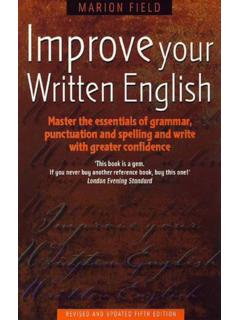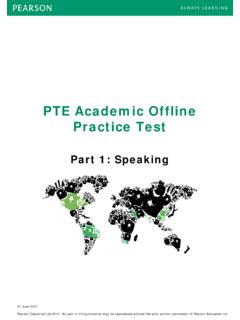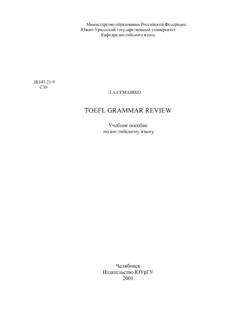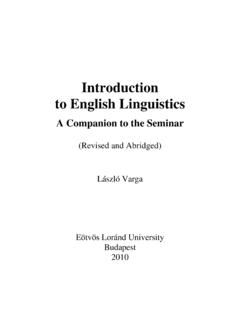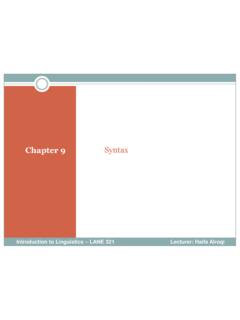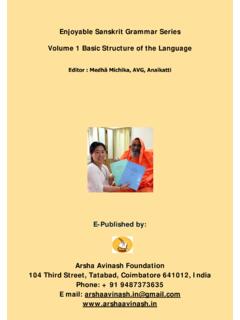Transcription of English Grammar : A University Course
1 English GRAMMARThis new edition of Downing and Locke s award-winning text-book has been thoroughlyrevised and rewritten by Angela Downing to offer an integrated account of structure,meaning and function in relation to context. Also used as a reference book, it providesthe linguistic basis for courses and projects on translation, contrastive linguistics,stylistics, reading and discourse studies. It is accessible and reader-friendly features include: Chapters divided into modules of class-length materials Each new concept clearly explained and highlighted Authentic texts from a wide range of sources, both spoken and written, to illustrategrammatical usage Clear chapter and module summaries enabling efficient class preparation andstudent revision Exercises and topics for individual study Answer key for analytical exercises Comprehensive index Select bibliography Suggestions for further reading This up-to-date, descriptive Grammar is a complete Course for first degree and post-graduate students of English , and is particularly suitable for those whose native languageis not Downingis Professor Emeritus in the Department of English Language andLinguistics ( English Philology I)
2 At the Universidad Complutense, late Philip Locketaught at the Institute of Modern Languages and Translation atthe Universidad Complutense, GRAMMARA University CourseSecond editionAngela Downingand Philip LockeFirst published 1992by Prentice Hall International (UK) LtdRoutledge edition published 2002 by RoutledgeThis second edition published 2006by Routledge2 Park Square, Milton Park, Abingdon, Oxon OX14 4 RNSimultaneously published in the USA and Canadaby Routledge270 Madison Ave, New York, NY 10016 Routledge is an imprint of the Taylor & Francis Group 2006 Angela Downing and Philip LockeAll rights reserved. No part of this book may be reprinted or reproduced or utilised in any form or by any electronic, mechanical, or other means, now known or hereafter invented, including photocopying and recording, or in any information storage or retrieval system, without permission in writing from the Library Cataloguing in Publication DataA catalogue record for this book is available from the British LibraryLibrary of Congress Cataloging in Publication DataA catalog record for this book has been requestedISBN10: 0 415 28787 1 ISBN13: 9 78 0 415 28787 6 (pbk)ISBN10: 0 415 28786 3 ISBN13: 9 78 0 415 28786 9 (hbk)This edition published in the Taylor & Francis e-Library, 2006.
3 To purchase your own copy of this or any of Taylor & Francis or Routledge scollection of thousands of eBooks please go to This book is for:Enriqueand to the memory of Philip LockeCONTENTSF orewordxiPreface to the second editionxiiiAcknowledgementsxvIntroductio nxviiTable of notational symbolsxxi1 Basic concepts1 Module 1 Language and meaning3 Module 2 Linguistic forms and syntactic functions9 Module 3 Negation and expansion21 Exercises282 The skeleton of the message: Introduction to clause structure32 Module 4 Syntactic functions and structures of the clause34 Module 5 Subject and Predicator42 Module 6 Direct, Indirect and Prepositional Objects50 Module 7 Subject and Object Complements64 Module 8 Adjuncts69 Further reading76 Exercises763 The development of the message: Complementation of the verb81 Introduction: Major complementation patterns and valency83 Module 9 Intransitive and copular patterns85 Module10 Transitive patterns90 Module 11 Complementation by finite clauses100 Module 12 Complementation by non-finite clauses108 Summary of complementation patterns114 Further reading116 Exercises1164 Conceptualising patterns of experience.
4 Processes, participants, circumstances120 Module 13 Conceptualising experiences expressed as situation types122 Module 14 Material processes of doing and happening128 Module 15 Causative processes132 Module 16 Processes of transfer137 Module 17 Conceptualising what we think, perceive and feel139 Module 18 Relational processes of being and becoming144 Module 19 Processes of saying, behaving and existing151 Module 20 Expressing attendant circumstances155 Module 21 Conceptualising experiences from a different angle: Nominalisation and grammatical metaphor160 Further reading167 Exercises1675 Interaction between speaker and hearer: Linking speech acts and grammar174 Module 22 Speech acts and clause types176 Module 23 The declarative and interrogative clause types180 Module 24 The exclamative and imperative clause types190 Module 25 Indirect speech acts, clause types and discourse functions197 Module 26 Questions, clause types and discourse functions201 Module 27 Directives: getting people to carry out actions205 Further reading212 Exercises2136 Organising the message: Thematic and information structures of the clause220 Module 28 Theme: the point of departure of the message222 Module 29 The distribution and focus of information238 Module 30 The interplay of Theme Rheme and Given New246 Further reading263 Exercises2637 Expanding the message.
5 Clause combinations270 Module 31 Clause combining272 Module 32 Types of relationship between clauses277 Module 33 Elaborating the message281 Module 34 Extending the message285 Module 35 Enhancing the message290 Module 36 Reporting speech and thought299 Further reading309 Exercises309viiiCONTENTS8 Talking about events: The Verbal Group315 Module 37 Expressing our experience of events317 Module 38 Basic structures of the Verbal Group323 Module 39 Organising our experience of events331 Module 40 The semantics of phrasal verbs336 Further reading343 Exercises3439 Viewpoints on events: Tense, aspect and modality350 Module 41 Expressing location in time through the verb: tense352 Module 42 Past events and present time connected: Present Perfectand Past Perfect361 Module 43 Situation types and the Progressive aspect369 Module 44 Expressing attitudes towards the event: modality379 Further reading394 Exercises39410 Talking about people and things: The Nominal Group399 Module 45 Expressing our experience of people and things401 Module 46 Referring to people and things as definite, indefinite, generic417 Module 47 Selecting and particularising the referent: the determiner423 Module 48 Describing and classifying the referent: the pre-modifier435 Module 49 Identifying and elaborating the referent: the post-modifier446 Module 50 Noun complement clauses457 Further reading462 Exercises46211 Describing persons, things and circumstances.
6 Adjectival and Adverbial groups473 Module 51 Adjectives and the adjectival group475 Module 52 Degrees of comparison and intensification484 Module 53 Complementation of the adjective494 Module 54 Adverbs and the adverbial group502 Module 55 Syntactic functions of adverbs and adverbial groups508 Module 56 Modification and complementation in the adverbial group515 Further reading521 Exercises52112 Spatial, temporal and other relationships: The Prepositional Phrase529 Module 57 Prepositions and the Prepositional Phrase531 Module 58 Syntactic functions of the Prepositional Phrase540 Module 59 Semantic features of the Prepositional Phrase546 CONTENTSixModule 60 Stranded prepositions; discontinuous prepositional phrases556 Further reading559 Exercises559 Answer Key564 Select Bibliography591 Index596xCONTENTSFOREWORDIt is now 13 years since the publication of Angela Downing and Philip Locke s A UniversityCourse in English Grammar , which broke new ground by offering to advanced studentsof English a comprehensive Course , based on Halliday s Systemic Functional went beyond the merely structural, to present an integrated account of structure andfunction, which gives students the information they need in order to link the grammarof English to the overall structure of discourse and to the contexts in which it is since its publication, the book has been used in many countries in South America,the Middle East and Europe, including of Course Spain.
7 To whose tertiary educationsystems both authors devoted the majority of their working lives. Downing and Locke sgrammar, while clearly rooted in Hallidayan linguistics, also responds to a number ofother influences, including the grammars of Quirk and his colleagues. However, it alsomade its own important contribution to our knowledge and understanding of manypoints of English Grammar , and has been widely cited by scholars working withinfunctional , Philip Locke died in 2003, but he would, I am sure, have been very proud ofthis new edition of the work, which still bears his name and has been retitled as EnglishGrammar: A University Course . The new version of the Grammar embodies three themesevident in Angela Downing s research work over the last decade or so, themes whichreflect the directions in which functional linguistics has moved in the late twentiethcentury and the beginning of the , the linking of Grammar to the structure and functioning of discourse, alreadyevident in the first edition, has been taken still further, giving students an even bettergrasp of aspects of text production in which even advanced foreign learners of Englishare often rather , the account of English Grammar offers benefits from the recognition that discourse is not a static product, but a constantly changing, negotiated process.
8 As interaction proceeds, interlocutors build up and modify mental representations of their addresses, the context and the discourse itself. This perspective on language leadsto the integration, within this new version of the Grammar , of ideas from , although the first edition of the Grammar drew on a wide range of sources toshow language in use, the new edition makes considerable use of examples from thelarge corpora now available for searching by computer (notably the 100-million-wordBritish National Corpus), as well as other textual materials collected by Angela result is that the Grammar is attractively illustrated by authentic text samples frommany registers of English , ranging from very informal conversation through to moreformal new version of the Downing and Locke Grammar will serve not only as a coursebook for new generations of advanced students of English , but also as a reference source for students, teachers and researchers looking for a detailed treatment of Englishgrammar which integrates structural, functional and cognitive perspectives into acoherent and satisfying ButlerHonorary ProfessorUniversity of Wales SwanseaxiiFOREWORDPREFACE TO THE SECOND EDITIONThe structure of this book remains essentially the same as that of the first edition.
9 Themost obvious difference is the collapsing of chapters 11 and 12 into one (adjectival andadverbial groups), leaving 12 (prepositions and the prepositional phrase) as the finalchapter. Following the welcome feedback from reviewers and consultants, there hasalso been some rearrangement of the material: in particular, the section on negation has been brought forward to Chapter 1, and the syntax of prepositional and phrasal verbsis made more explicit in Chapter 2. Chapter 5 has also been rearranged, in order to clarifythe correspondences between clause types and their speech act of the modules have been considerably rewritten, in order to accomodate thedescription of certain elements that had not been dealt with. Still others were partlyrewritten in order to incorporate certain insights and research findings published since1990 or, if earlier, not included in the first edition.
10 The motion event analysis in Chapter8 is one of these, and the semantics of prepositions in Chapter 12 is another. A fewanalytical changes have been made, notably the re-analysis of those features that weregrouped together under the function labelled predicator complement . This re-analysishas been made possible by a clearer specification of the criteria adopted for theclassification of clause constituents. A considerable number of new textual illustrations have been i
